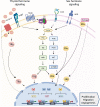Hormonal Crosstalk Between Thyroid and Breast Cancer
- PMID: 35587175
- PMCID: PMC9653009
- DOI: 10.1210/endocr/bqac075
Hormonal Crosstalk Between Thyroid and Breast Cancer
Abstract
Differentiated thyroid cancer and breast cancer account for a significant portion of endocrine-related malignancies and predominately affect women. As hormonally responsive tissues, the breast and thyroid share endocrine signaling. Breast cells are responsive to thyroid hormone signaling and are affected by altered thyroid hormone levels. Thyroid cells are responsive to sex hormones, particularly estrogen, and undergo protumorigenic processes upon estrogen stimulation. Thyroid and sex hormones also display significant transcriptional crosstalk that influences oncogenesis and treatment sensitivity. Obesity-related adipocyte alterations-adipocyte estrogen production, inflammation, feeding hormone dysregulation, and metabolic syndromes-promote hormonal alterations in breast and thyroid tissues. Environmental toxicants disrupt endocrine systems, including breast and thyroid homeostasis, and influence pathologic processes in both organs through hormone mimetic action. In this brief review, we discuss the hormonal connections between the breast and thyroid and perspectives on hormonal therapies for breast and thyroid cancer. Future research efforts should acknowledge and further explore the hormonal crosstalk of these tissues in an effort to further understand the prevalence of thyroid and breast cancer in women and to identify potential therapeutic options.
Keywords: breast cancer; estrogen; obesity; thyroid cancer; thyroid hormones.
© The Author(s) 2022. Published by Oxford University Press on behalf of the Endocrine Society. All rights reserved. For permissions, please e-mail: journals.permissions@oup.com.
Figures


Comment in
-
Letter to the Editor From Wang et al.: "Hormonal Crosstalk Between Thyroid and Breast Cancer".Endocrinology. 2023 Feb 11;164(4):bqad009. doi: 10.1210/endocr/bqad009. Endocrinology. 2023. PMID: 36772947 No abstract available.
Similar articles
-
[Hormonal therapy in oncologic treatment: pathogenic hypotheses and interactions between thyroid and breast pathologies].Tumori. 2003 Jul-Aug;89(4 Suppl):215-9. Tumori. 2003. PMID: 12903598 Italian.
-
Regulation of cell growth by estrogen signaling and potential targets in thyroid cancer.Curr Cancer Drug Targets. 2008 Aug;8(5):367-77. doi: 10.2174/156800908785133150. Curr Cancer Drug Targets. 2008. PMID: 18690843 Review.
-
Mechanisms of crosstalk between endocrine systems: regulation of sex steroid hormone synthesis and action by thyroid hormones.Gen Comp Endocrinol. 2014 Jul 1;203:69-85. doi: 10.1016/j.ygcen.2014.03.015. Epub 2014 Mar 29. Gen Comp Endocrinol. 2014. PMID: 24685768 Review.
-
The prediction of hormonal dependency of mammary cancer.Ann Surg. 1975 Sep;182(3):342-52. doi: 10.1097/00000658-197509000-00017. Ann Surg. 1975. PMID: 169754 Free PMC article.
-
Sex steroid induced apoptosis as a rational strategy to treat anti-hormone resistant breast and prostate cancer.Discov Med. 2016 May;21(117):411-27. Discov Med. 2016. PMID: 27355337
Cited by
-
The Role of Lipid Metabolism Disorders in the Development of Thyroid Cancer.Int J Mol Sci. 2024 Jun 28;25(13):7129. doi: 10.3390/ijms25137129. Int J Mol Sci. 2024. PMID: 39000236 Free PMC article. Review.
-
Risk Factors for Granulomatous Mastitis and Establishment and Validation of a Clinical Prediction Model (Nomogram).Risk Manag Healthc Policy. 2023 Oct 20;16:2209-2222. doi: 10.2147/RMHP.S431228. eCollection 2023. Risk Manag Healthc Policy. 2023. PMID: 37881167 Free PMC article.
-
TP53 gene mutation in lymphoepithelioma‑like carcinoma of the breast with thyroid cancer: A case report.Oncol Lett. 2025 Mar 26;29(5):247. doi: 10.3892/ol.2025.14993. eCollection 2025 May. Oncol Lett. 2025. PMID: 40177135 Free PMC article.
-
Secular Increasing Trends in Female Thyroid Cancer Incidence in Taiwan.Life (Basel). 2024 Jun 26;14(7):809. doi: 10.3390/life14070809. Life (Basel). 2024. PMID: 39063564 Free PMC article.
-
Development of a prediction model for the association between thyroid dysfunction and breast cancer.Transl Cancer Res. 2024 Jun 30;13(6):2790-2798. doi: 10.21037/tcr-23-2164. Epub 2024 Jun 24. Transl Cancer Res. 2024. PMID: 38988922 Free PMC article.
References
Publication types
MeSH terms
Substances
Grants and funding
LinkOut - more resources
Full Text Sources
Medical
Research Materials

